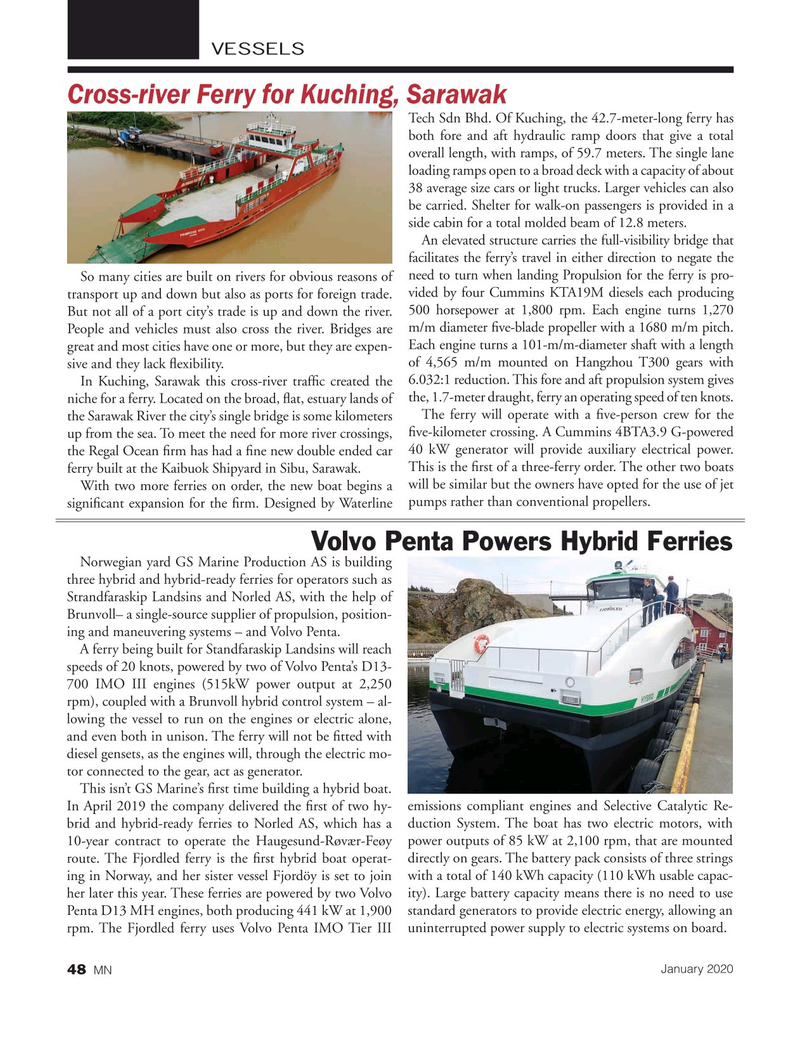
Page 48: of Marine News Magazine (January 2020)
Passenger Vessels & Ferries
Read this page in Pdf, Flash or Html5 edition of January 2020 Marine News Magazine
VESSELS
Cross-river Ferry for Kuching, Sarawak
Tech Sdn Bhd. Of Kuching, the 42.7-meter-long ferry has both fore and aft hydraulic ramp doors that give a total overall length, with ramps, of 59.7 meters. The single lane loading ramps open to a broad deck with a capacity of about 38 average size cars or light trucks. Larger vehicles can also be carried. Shelter for walk-on passengers is provided in a side cabin for a total molded beam of 12.8 meters.
An elevated structure carries the full-visibility bridge that facilitates the ferry’s travel in either direction to negate the
So many cities are built on rivers for obvious reasons of need to turn when landing Propulsion for the ferry is pro- transport up and down but also as ports for foreign trade. vided by four Cummins KTA19M diesels each producing
But not all of a port city’s trade is up and down the river. 500 horsepower at 1,800 rpm. Each engine turns 1,270
People and vehicles must also cross the river. Bridges are m/m diameter ? ve-blade propeller with a 1680 m/m pitch.
Each engine turns a 101-m/m-diameter shaft with a length great and most cities have one or more, but they are expen- of 4,565 m/m mounted on Hangzhou T300 gears with sive and they lack ? exibility.
In Kuching, Sarawak this cross-river traf? c created the 6.032:1 reduction. This fore and aft propulsion system gives niche for a ferry. Located on the broad, ? at, estuary lands of the, 1.7-meter draught, ferry an operating speed of ten knots.
The ferry will operate with a ? ve-person crew for the the Sarawak River the city’s single bridge is some kilometers up from the sea. To meet the need for more river crossings, ? ve-kilometer crossing. A Cummins 4BTA3.9 G-powered the Regal Ocean ? rm has had a ? ne new double ended car 40 kW generator will provide auxiliary electrical power.
This is the ? rst of a three-ferry order. The other two boats ferry built at the Kaibuok Shipyard in Sibu, Sarawak.
With two more ferries on order, the new boat begins a will be similar but the owners have opted for the use of jet signi? cant expansion for the ? rm. Designed by Waterline pumps rather than conventional propellers.
Volvo Penta Powers Hybrid Ferries
Norwegian yard GS Marine Production AS is building three hybrid and hybrid-ready ferries for operators such as
Strandfaraskip Landsins and Norled AS, with the help of
Brunvoll– a single-source supplier of propulsion, position- ing and maneuvering systems – and Volvo Penta.
A ferry being built for Standfaraskip Landsins will reach speeds of 20 knots, powered by two of Volvo Penta’s D13- 700 IMO III engines (515kW power output at 2,250 rpm), coupled with a Brunvoll hybrid control system – al- lowing the vessel to run on the engines or electric alone, and even both in unison. The ferry will not be ? tted with diesel gensets, as the engines will, through the electric mo- tor connected to the gear, act as generator.
This isn’t GS Marine’s ? rst time building a hybrid boat.
In April 2019 the company delivered the ? rst of two hy- emissions compliant engines and Selective Catalytic Re- brid and hybrid-ready ferries to Norled AS, which has a duction System. The boat has two electric motors, with 10-year contract to operate the Haugesund-Røvær-Feøy power outputs of 85 kW at 2,100 rpm, that are mounted route. The Fjordled ferry is the ? rst hybrid boat operat- directly on gears. The battery pack consists of three strings ing in Norway, and her sister vessel Fjordöy is set to join with a total of 140 kWh capacity (110 kWh usable capac- her later this year. These ferries are powered by two Volvo ity). Large battery capacity means there is no need to use
Penta D13 MH engines, both producing 441 kW at 1,900 standard generators to provide electric energy, allowing an rpm. The Fjordled ferry uses Volvo Penta IMO Tier III uninterrupted power supply to electric systems on board.
January 2020 48 MN

 47
47

 49
49
